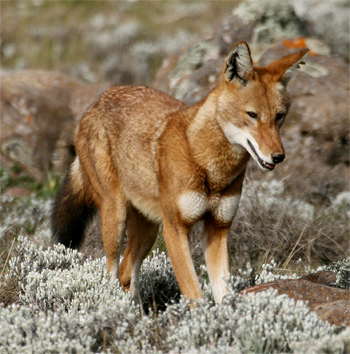- Habitat-Mainly in Southeastern United States, from Texas north to Illinois. Likes a hot, moist climate.
- Random Facts-The Red Wolf was earlier thought to be a descendant of a cross between the Gray Wolf and the Coyote until they found fossils of Red Wolves far older than Gray Wolves and Coyotes.
- The breed is considered to be extinct in the wild because of Hybridization. This means that they are breeding with coyotes because they are more common than other Red Wolves. They also breed with the same mate throughout life.
All Kinds of Wolves
The scientific name for the wolf is "Canis lupus."
-Order-Carnivore
-Family-Canidae
Wolf Quotes
"For the strength of the Pack is the Wolf, and the strength of the Wolf is the Pack." -Rudyard Kipling
"The wolf is kept fed by its feet." -Russian Proverb
"How lonely is the night without the howl of a wolf." -Unknown
Sunday, April 22, 2012
Red Wolf
The Scientific name for the Red Wolf is Canis Rufus.
Saturday, April 21, 2012
Communication
EAV:fe5dd4b85096b2af
Wolves communicate with each other harmoniously rather than aggressively. Wolves usually defend their territories through vocalizations and scent marks. Here are some examples of wolf communication tactics:
Wolves communicate with each other harmoniously rather than aggressively. Wolves usually defend their territories through vocalizations and scent marks. Here are some examples of wolf communication tactics:
- Vocalizations
- Scent marks
- Visual displays
- Facial and body rituals
- Howling
Monday, January 9, 2012
Ethiopian Wolf
The Scientific name for the Ethiopian Wolf is Canis Simensis.

- Habitat-Obviously from Ethiopa, Africa. Most of the population, about 50% live in the Bale Mountains. They live in higher altitudes.
- This wolf is considered to be endangered. The cause of this is mainly humans.
- Other names for the wolf include: Simien fox and Simien Jackal.

Tuesday, January 3, 2012
Arctic Wolf
The scientific name for the Arctic Wolf is canis lupus arctos.
Appearance-Generally smaller than the Gray Wolf with a shorter muzzle, shorter ears, and shorter legs.
Their main predators are polar bears, humans, and other wolves.
Their packs usually include about 6 wolves.
It is the only subspecies of the Gray Wolf to still range the entire span of its original habitat. This is mainly because humans have not migrated as far north as they have.
They are listed on the endangered species list as "least concern" but are hunted heavily for their pelts. 
- Habitat-Mainly in Alaska, Northern Canada, and the Eastern and Northern shores of Greenland, with just a few in New Zealand. They live in some of the most inhospitable places on earth. The temperature where they live hardly ever rises above -22 degrees Fahrenheit.


Monday, January 2, 2012
Wolves-Endangered
Wolves are an extremely important part of an ecosystem. They help keep the species that are their prey in control. People are fearful of wolves, but they have no reason to be. There has never been an account of a wild wolf attacking a human. Wolves will always go for the weakest prey. That means that you have very little to fear of them attacking healthy livestock and they keep the food chain in order. Without wolves in the world, there would gradually become an overpopulation of deer and other prey of the wolf. With an overpopulation of these, there is in turn an under-population of their prey (plants, smaller animals) and thus disrupting the entire course of existence for many other species.
Lifespan
In the wild wolves tend to live to be around 6-8 years old. In captivity, they can live to be around 16 years old. The oldest wolf ever documented lived to be about 14 years in the wild. In captivity, the oldest documented wolf was 21 years old.
Subscribe to:
Posts (Atom)

